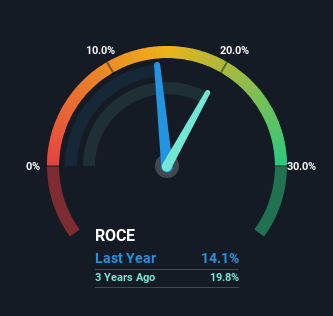- United States
- /
- Specialty Stores
- /
- NYSE:BOOT
Slowing Rates Of Return At Boot Barn Holdings (NYSE:BOOT) Leave Little Room For Excitement

What trends should we look for it we want to identify stocks that can multiply in value over the long term? One common approach is to try and find a company with returns on capital employed (ROCE) that are increasing, in conjunction with a growing amount of capital employed. This shows us that it's a compounding machine, able to continually reinvest its earnings back into the business and generate higher returns. With that in mind, the ROCE of Boot Barn Holdings (NYSE:BOOT) looks decent, right now, so lets see what the trend of returns can tell us.
Return On Capital Employed (ROCE): What Is It?
For those who don't know, ROCE is a measure of a company's yearly pre-tax profit (its return), relative to the capital employed in the business. Analysts use this formula to calculate it for Boot Barn Holdings:
Return on Capital Employed = Earnings Before Interest and Tax (EBIT) ÷ (Total Assets - Current Liabilities)
0.14 = US$204m ÷ (US$1.8b - US$323m) (Based on the trailing twelve months to June 2024).
Thus, Boot Barn Holdings has an ROCE of 14%. That's a relatively normal return on capital, and it's around the 12% generated by the Specialty Retail industry.
View our latest analysis for Boot Barn Holdings

In the above chart we have measured Boot Barn Holdings' prior ROCE against its prior performance, but the future is arguably more important. If you're interested, you can view the analysts predictions in our free analyst report for Boot Barn Holdings .
What The Trend Of ROCE Can Tell Us
The trend of ROCE doesn't stand out much, but returns on a whole are decent. The company has consistently earned 14% for the last five years, and the capital employed within the business has risen 163% in that time. Since 14% is a moderate ROCE though, it's good to see a business can continue to reinvest at these decent rates of return. Stable returns in this ballpark can be unexciting, but if they can be maintained over the long run, they often provide nice rewards to shareholders.
On a side note, Boot Barn Holdings has done well to reduce current liabilities to 18% of total assets over the last five years. This can eliminate some of the risks inherent in the operations because the business has less outstanding obligations to their suppliers and or short-term creditors than they did previously.
The Bottom Line
In the end, Boot Barn Holdings has proven its ability to adequately reinvest capital at good rates of return. And the stock has done incredibly well with a 321% return over the last five years, so long term investors are no doubt ecstatic with that result. So while investors seem to be recognizing these promising trends, we still believe the stock deserves further research.
If you're still interested in Boot Barn Holdings it's worth checking out our FREE intrinsic value approximation for BOOT to see if it's trading at an attractive price in other respects.
While Boot Barn Holdings isn't earning the highest return, check out this free list of companies that are earning high returns on equity with solid balance sheets.
Valuation is complex, but we're here to simplify it.
Discover if Boot Barn Holdings might be undervalued or overvalued with our detailed analysis, featuring fair value estimates, potential risks, dividends, insider trades, and its financial condition.
Access Free AnalysisHave feedback on this article? Concerned about the content? Get in touch with us directly. Alternatively, email editorial-team (at) simplywallst.com.
This article by Simply Wall St is general in nature. We provide commentary based on historical data and analyst forecasts only using an unbiased methodology and our articles are not intended to be financial advice. It does not constitute a recommendation to buy or sell any stock, and does not take account of your objectives, or your financial situation. We aim to bring you long-term focused analysis driven by fundamental data. Note that our analysis may not factor in the latest price-sensitive company announcements or qualitative material. Simply Wall St has no position in any stocks mentioned.
About NYSE:BOOT
Boot Barn Holdings
Operates specialty retail stores in the United States and internationally.
Flawless balance sheet with solid track record.
Similar Companies
Market Insights
Community Narratives




